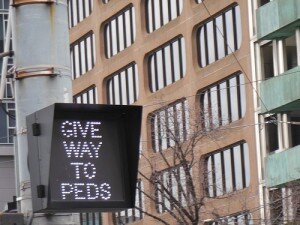Barbarous mutilations
Image: Peds = Pedestrians via PhotoPin (licence)
Text messaging, tweeting and other electronic communications have led to an increasing use of abbreviations over the past few years. Some of us might grumble at this informality, but it was ever thus – the ancient Greeks and Romans shortened words to save space and time, even when chiselling into a stone tablet, as did medieval scribes scratching away with inky quill on parchment.
Fashions come and go – in 1712 the English writer Jonathan Swift characterised abbreviations or ‘curtailments’ of words as ‘barbarous mutilations’ – but we have never stopped shortening words. Many terms that we use today as complete words are in fact 19th-century abbreviations. Most English speakers would know that ad comes from advertisement, bike from bicycle and flu from influenza. But perhaps some of us are unaware that pants comes from pantaloons, cab from cabriolet and pram from perambulator.
This brings us to the thorny matter of punctuation. All these abbreviations lost their full stop long ago. Even some relatively new ones, like app for application, are allowed to stand alone (and obviously, using full stops when tweeting and texting would defeat the purpose of the abbreviations that have developed, if u c wot I mean.
But in formal text, what is the convention for punctuating words that still feel like abbreviations? In Australia (like Britain), we generally use a full stop only when the last letter of the abbreviation is not the last letter of the original word. So it is Dr Nguyen but Prof. Pangloss; Pty Ltd for Proprietary Limited but Co. for Company. Also, Australians no longer punctuate initialisms such as USA and TAFE, or acronyms such as Anzac and Qantas, but many American publishers do, even such everyday terms as Dr. and U.S.A.
To form the plural of a shortened word or phrase, just add s, without an apostrophe. It is MPs not MP’s and FAQs not FAQ’s. Sometimes this will mean dropping the full stop: in captions, bibliographies and the like we use fig. and figs (for figure and figures); para. and paras (for paragraphs) and ed. and eds (for editor and editors).

